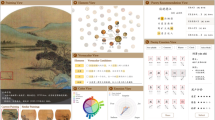Abstract
In order to preserve cultural heritage, this paper proposes to develop a digital paintings visualization system. Our proposed system mainly consists of extracting regions of interest (ROI) from a digital painting to characterize them. These close-ups are then animated on the basis of the painting characteristics and the artist’s or designer’s aim. In order to obtain interesting results from short video clips, we developed a visual saliency map-based method by using the well-known Itti’s saliency analysis which already proved its efficiency on paintings. The experimental results show the efficiency of our approach and an evaluation based on a Mean Opinion Score validates the proposed method. Eighteen volunters watched for a total of 216 views at 72 video clips build up from 6 paintings, and we found a significant difference between our saliency-based generated videos and random-based generated videos.










Similar content being viewed by others
References
Aziz MZ, Mertsching B (2008) Fast and robust generation of feature maps for region-based visual attention. Trans Img Proc 17(5):633–644
Condorovici RG, Vranceanu R, Vertan C (2011) Saliency map retrieval for artistic paintings inspired from human understanding. In: SPAMEC
Gallo G, Stanco F, Battiato S (2011) Digital imaging for cultural heritage preservation: analysis, restoration and reconstruction of ancient artworks. Taylor and Francis
Greenspan H, Belongie S, Goodman R, Perona P, Rakshit S, Anderson CH (1994) Overcomplete steerable pyramid filters and rotation invariance. In: Proceedings of the IEEE conference on computer vision and pattern recognition, pp 222–228
Giakoumis I, Nikolaidis N, Pitas I (2006) Digital image processing techniques for the detection and removal of cracks in digitized paintings. IEEE Trans Image Process 15(1):178–188
Guo C, Zhang L (2010) A novel multiresolution spatiotemporal saliency detection model and its applications in image and video compression. Trans Img Proc 19(1):185–198
Harel J, Koch C, Perona P (2006) Graph-based visual saliency. In: NIPS, pp 545–552
Haralick RM, Shanmugam K, Dinstein Its’Hak (1973) Textural features for image classification. IEEE Trans Syst Man Cybern SMC 3(6):610–621
Itti L, Koch C (1999) A comparison of feature combination strategies for saliency-based visual attention systems. J Electron Imaging 10:161–169
Itti L, Koch C, Niebur E (1998) A model of saliency-based visual attention for rapid scene analysis. IEEE Trans Pattern Anal Mach Intell 20(11):1254–1259
Itti L (2000) Models of bottom-up and top-down visual attention. PhD thesis, California Institute of Technology, Pasadena, California
Khan FS, Beigpour S, Weijer J, Felsberg M (2014) Painting-91: a large scale database for computational painting categorization. Mach Vision Appl 25(6):1385–1397
Koch C, Ullman S (1985) Shifts in selective visual attention: towards the underlying neural circuitry. Hum Neurobiol 4:219–227
McNamara A, Booth T, Sridharan S, Caffey S, Grimm C, Bailey R (2012) Directing gaze in narrative art. In: Proceedings of the ACM Symposium on Applied Perception, SAP ’12. ACM, New York, NY, USA, pp 63–70
Niebur E (2007) Saliency map. Scholarpedia 2(8):2675
Oyeka A, Ebuh G (2012) Modified wilcoxon signed-rank test. Open J Stat 2:172–176
ITU-T Recommendation (P.910) (2000) Subjective video quality assessment methods for multimedia applications
Pitzalis D, Aitken G, Autrusseau F, Babel M, Cayre F, Puech W (2008) Tsar: secure transfer of high resolution art images. In: Proceedings of EVA’08 Florence, Electronic imaging and the Visual Art, France
Platia L, Cornelis B, Ruic T, Piurica A, Dooms A, Martens M, De Mey M, Daubechies I (2011) Spatiogram features to characterize pearls in paintings. In: Proceedings of IEEE ICIP'2011
Pei S-C, Ding J-J, Chang J-H (2001) Efficient implementation of quaternion fourier transform, convolution, and correlation by 2-d complex fft. IEEE Trans Signal Process 49(11):2783–2797
Quian Quiroga R, Pedreira C (2011) How do we see art: An eye-tracker study. Front Hum Neurosci 5:98
van der Maaten L, Postma E (2009) Identifying the real van gogh with brushstroke textons. White paper, Tilburg University (February 2009)
Wolfe JM, Horowitz TS (2004) What attributes guide the deployment of visual attention and how do they do it? Nat Rev Neurosci 5(6):495–501
Wu B, Xu L, Zeng L, Wang Z, Wang Y (2013) A unified framework for spatiotemporal salient region detection. EURASIP J Image Video Process 2013(1):16
Xu L, Li H, Zeng L, Ngan KN (2013) Saliency detection using joint spatial-color constraint and multi-scale segmentation. J Vis Comun Image Represent 24(4):465–476
Zollner F (1993) Leonardo’s Portrait of Mona Lisa del Giocondo. Gazette des Beaux-Arts 121(1):115–138
Acknowledgment
The authors would like to thank volunteers who accepted to participate in our opinion score campaign.
Author information
Authors and Affiliations
Corresponding author
Electronic supplementary material
Below is the link to the electronic supplementary material.
(5.83 MB)
(5.85 MB)
Rights and permissions
About this article
Cite this article
Kennel, P., Puech, W. & Comby, F. Visualization framework of digital paintings based on visual saliency for cultural heritage. Multimed Tools Appl 76, 561–575 (2017). https://doi.org/10.1007/s11042-015-3013-7
Received:
Revised:
Accepted:
Published:
Issue Date:
DOI: https://doi.org/10.1007/s11042-015-3013-7




